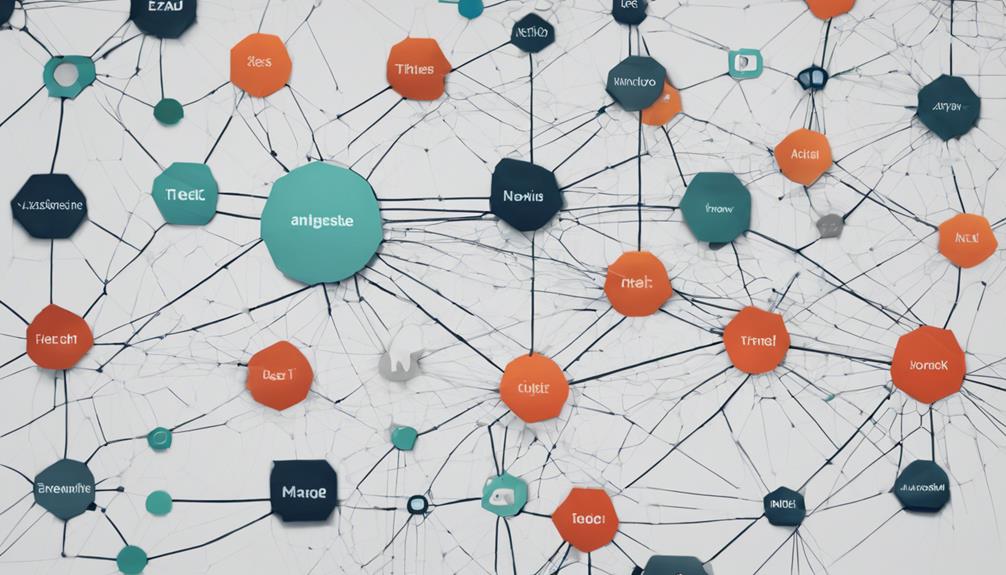AI and machine learning are transforming cybersecurity, enhancing defense mechanisms through real-time threat detection and automating tasks for better operational efficiency. By analyzing vast datasets, proactive defense strategies are devised, with a focus on pattern recognition and anomaly classification. This transformative impact is seen in modern defense practices, with anomaly detection techniques, behavior analysis for threat detection, and predictive analytics reinforcing security measures. Leveraging these technologies offers a proactive approach to cybersecurity, empowering organizations to anticipate and mitigate potential threats effectively. Embracing AI/ML in cybersecurity guarantees a robust defense against evolving cyber threats. Learn more about these cutting-edge advancements.
Key Takeaways
- AI enhances defense with real-time threat detection.
- ML automates tasks for operational efficiency.
- Analyzing vast datasets for proactive defense.
- ML plays a key role in anomaly classification.
- Transforming modern defense practices with AI/ML.
Importance of Ai/Ml in Cybersecurity
The significance of AI and ML in cybersecurity lies in their ability to bolster defense mechanisms through real-time threat detection and response capabilities. By harnessing the power of AI and ML algorithms, organizations can enhance their cybersecurity posture by automating tasks, improving operational efficiency, and strengthening overall security strategies.
These technologies excel in analyzing vast datasets to identify potential risks, contributing to more proactive defense strategies against evolving cyber threats. AI and ML play an important role in pattern recognition, anomaly classification, and predicting cyber threats based on historical data, enabling security teams to stay ahead of malicious actors.
Leveraging these technologies not only enhances the effectiveness of security operations centers (SOCs) but also helps in automating mundane tasks, allowing cybersecurity professionals to focus on more strategic initiatives. Ultimately, the value of AI and ML in cybersecurity is demonstrated through achieving good security outcomes with limited resources, highlighting the transformative impact these technologies have on modern defense practices.
Anomaly Detection Using Machine Learning

Utilizing machine learning techniques allows for the identification of abnormal patterns in systems or networks, enhancing cybersecurity defenses through anomaly detection. By leveraging machine learning algorithms trained on substantial datasets, organizations can effectively distinguish between benign deviations and potential threats.
AI-driven anomaly detection continuously improves by learning from data, refining detection capabilities over time. Monitoring data access and transfer patterns in cloud storage platforms enables prompt flagging of potential data breach attempts, bolstering overall security measures.
In contrast, traditional systems may inundate security teams with numerous false alarms when detecting any deviation, underscoring the necessity for AI-driven anomaly detection solutions. These advanced technologies not only reduce the burden of false alarms but also enhance the accuracy and efficiency of threat detection processes.
Behavior Analysis for Threat Detection

Behavior analysis in cybersecurity involves profiling user interactions to detect abnormal patterns, such as odd-hour logins or unauthorized data access.
AI algorithms create unique digital fingerprints for each user, enabling the identification of anomalies like high-level executives accessing sensitive data late at night.
Anomaly Detection Techniques
An essential component of modern cybersecurity strategies involves employing advanced anomaly detection techniques to identify abnormal patterns within systems or networks. Behavior analysis, utilizing AI-driven anomaly detection, plays a critical role in this process. By monitoring data access and transfer patterns, anomalies such as odd-hour logins or unusual data access can be swiftly identified.
Machine learning algorithms, particularly when trained on substantial datasets, excel at discerning benign deviations from potential security threats, thereby enhancing anomaly detection in cybersecurity. Over time, AI-driven anomaly detection becomes more effective as it learns from data, continuously refining its capabilities to detect threats proactively.
Cloud storage platforms, in particular, benefit from behavior analysis, promptly flagging potential data breach attempts by analyzing user interactions. The synergy between anomaly detection and behavior analysis underlines the importance of leveraging cutting-edge technologies to bolster cyber defense mechanisms and protect crucial digital assets.
Predictive Modeling Applications
Predictive modeling applications play a pivotal role in cybersecurity by leveraging AI algorithms to proactively analyze user behaviors for threat detection and prevention. Utilizing predictive analytics and ML models, behavior analysis focuses on detecting anomalies in user behavior that could indicate potential security threats. By employing AI-driven behavior analysis, cybersecurity systems can swiftly identify deviations such as odd-hour logins or unusual data access patterns.
These AI systems create digital fingerprints that help in spotting abnormal user behaviors, like accessing sensitive data at irregular times. Promptly flagging potential security breaches, such as high-level executives accessing critical data late at night, is essential in preventing account takeovers and other cyber threats.
The ability to detect anomalies in user behavior efficiently enables cybersecurity teams to understand how legitimate users typically interact with systems and respond effectively to abnormal activities. This proactive approach to threat detection enhances overall cybersecurity defenses and reduces the risk of potential breaches.
User Behavior Profiling
Utilizing advanced AI algorithms, user behavior profiling in cybersecurity plays a critical role in proactively identifying potential security threats through the analysis of digital interactions and deviations.
By creating digital fingerprints for users, behavior analysis tracks interactions and detects deviations, such as odd-hour logins or accessing unfamiliar data segments, promptly flagging unusual behavior.
The aim is to prevent security breaches by profiling how legitimate users typically interact with systems and identifying abnormal activities using AI algorithms. For instance, spotting a high-level executive accessing sensitive data late at night could signal a potential account takeover attempt.
Furthermore, behavior analysis is instrumental in detecting insider threats and unauthorized access by continuously monitoring user behavior patterns.
Predictive Analytics in Cybersecurity Defense

Predictive analytics in cybersecurity defense offers a proactive approach to strengthening security measures.
By utilizing threat detection models, anomaly detection techniques, and behavioral analysis applications, organizations can anticipate and mitigate potential cyber threats before they materialize.
These tools leverage historical data to forecast future attack trends and patterns, empowering companies to stay ahead of evolving cybersecurity challenges.
Threat Detection Models
Implementing advanced AI and ML technologies in cybersecurity defense enables organizations to enhance threat detection models through the analysis of historical data. By utilizing machine learning and predictive analytics, companies can identify patterns and trends from past security incidents to predict potential future threats.
Insights gained from this predictive analytics process empower organizations to proactively strengthen their cybersecurity defenses against evolving cyber threats.
These threat detection models leverage historical data to predict potential future attack types, allowing for the implementation of proactive defense measures. By staying ahead of cyber threats through the use of predictive analytics, organizations can better prepare themselves and mitigate potential risks before they escalate.
This proactive approach not only enhances overall cybersecurity posture but also helps in safeguarding sensitive data and critical systems from malicious actors. Leveraging threat detection models powered by machine learning and predictive analytics is a pivotal step towards bolstering cybersecurity defenses in today's constantly evolving threat landscape.
Anomaly Detection Techniques
Anomaly detection techniques in cybersecurity defense leverage machine learning to identify deviations from normal operation patterns in systems. By employing machine learning algorithms, cybersecurity experts can effectively distinguish between benign deviations and potential threats, greatly enhancing detection accuracy.
Predictive analytics plays a vital role in anomaly detection, utilizing historical data to predict and prevent future cyber threats before they materialize. Monitoring data access and transfer patterns in cloud storage platforms is a key strategy in promptly flagging potential data breach attempts, enabling proactive cybersecurity measures.
Moreover, AI-driven anomaly detection continuously improves over time by learning from data and refining detection capabilities. This iterative process enhances the effectiveness of anomaly detection systems, making them more adept at identifying and mitigating evolving cyber threats.
Behavioral Analysis Applications
Utilizing AI algorithms, behavioral analysis in cybersecurity involves creating digital fingerprints to track user interactions and identify deviations for enhanced threat detection capabilities. By detecting abnormal behavior, such as odd-hour logins or unusual data access patterns, AI-driven behavioral analysis can promptly flag anomalies for potential security threats.
This essential defense approach is vital for preventing security breaches, especially when it comes to identifying abnormal user activities like high-level executives accessing sensitive data at irregular times.
Predictive analytics plays a significant role in cybersecurity by utilizing AI and ML to analyze past incidents, predict future threats, and enhance proactive defense strategies. AI-powered behavioral analysis tools are designed to prevent security breaches effectively by swiftly identifying and responding to abnormal user activities.
Enhancing Phishing Detection With AI

AI technology plays an essential role in enhancing the detection of phishing attempts, particularly in emails. Machine learning algorithms, a subset of AI techniques, have revolutionized cybersecurity by swiftly identifying and flagging suspicious emails. These algorithms are trained on extensive datasets to distinguish between legitimate and phishing emails, enabling them to detect subtle indicators of phishing attempts that might go unnoticed by traditional methods. By analyzing email structures for inconsistencies, AI systems can efficiently identify potential phishing emails, even those designed to evade detection through sophisticated techniques. This capability is important in preventing costly mistakes and safeguarding organizations against cyber threats. Below is a table highlighting the key benefits of using AI in phishing detection:
| Benefits of AI in Phishing Detection |
|---|
| Efficiently detects subtle indicators of phishing attempts |
| Trained on vast datasets to differentiate between legitimate and phishing emails |
| Identifies inconsistencies in email structures to flag potential phishing emails |
| Detects sophisticated phishing attempts through AI-driven solutions |
| Swiftly identifies and flags suspicious emails to prevent cybersecurity breaches |
Automated Threat Hunting Techniques

Enhancing cybersecurity defenses, automated threat hunting techniques involve actively scanning networks to detect patterns, anomalies, or behaviors indicating potential threats.
By leveraging AI-driven systems, organizations can achieve continuous monitoring capabilities, enabling the swift detection and neutralization of threats at their earliest stages.
Proactive threat hunting tools, powered by AI, can identify patterns resembling past attacks, facilitating early isolation and investigation to prevent potential breaches.
Constant vigilance through AI-powered threat hunting greatly enhances the cybersecurity posture by detecting and neutralizing threats before they cause damage.
Automating the process of seeking out potential threats, AI-driven threat hunting shifts the focus from reactive to proactive defense strategies, ensuring a more robust security framework.
Frequently Asked Questions
How Are AI and Machine Learning Improving Cybersecurity?
AI and machine learning are enhancing cybersecurity by efficiently analyzing data, automating incident responses, improving response times, and enabling proactive defense. These technologies play a crucial role in identifying unknown threats, managing vulnerabilities, and predicting and countering threats in cyber defense.
How AI Can Be Used in Cyber Security Defences?
In the domain of cybersecurity defenses, AI plays a pivotal role by enhancing anomaly detection, behavior analysis, predictive analytics, automated threat hunting, and phishing detection. Leveraging machine learning, AI fortifies networks against evolving cyber threats.
What Is Leveraging AI in Cybersecurity?
Leveraging AI in cybersecurity involves harnessing advanced technologies to analyze data, detect patterns, and identify potential threats in real-time. This proactive approach enables organizations to enhance their defense strategies, improve response times, and bolster overall security posture.
What Is Aiml in Cyber Security?
AI/ML in cybersecurity refers to utilizing artificial intelligence and machine learning technologies to bolster defense mechanisms against cyber threats. By applying data analytics and pattern recognition, AI/ML aids in identifying anomalies and potential security breaches for enhanced protection.
Conclusion
To summarize, the integration of AI and ML in cybersecurity is essential for enhancing defense mechanisms against evolving threats. By leveraging machine learning for anomaly detection, behavior analysis, predictive analytics, phishing detection, and automated threat hunting, organizations can strengthen their security posture and stay ahead of malicious actors.
The potential for AI and ML to revolutionize cybersecurity is nothing short of extraordinary, offering a powerful toolset for protecting sensitive data and mitigating risks in the digital landscape.









